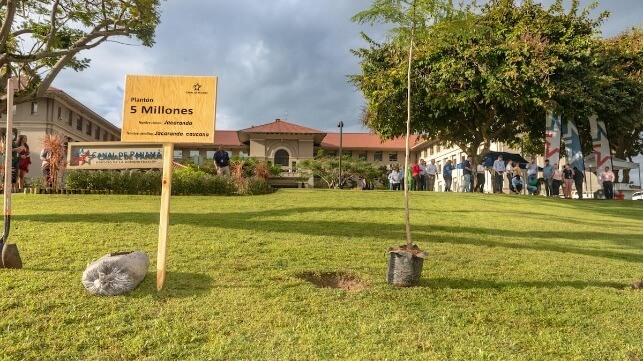The Panama Canal Celebrates 21 Years of Reforestation

The Panama Canal commemorated with the symbolic planting of a seedling in the Canal Administration Building the 5 millionth tree of the Panama Canal Environmental Economic Incentives Program (PIEA).
In the 21 years since the Program began, some five million trees have been planted in areas belonging to the Hydrographic Basin.
This figure is of great significance and symbolism because it represents one plant for each Panamanian, mainly with the purpose of protecting the environment and, consequently, the water resource.
With the planting of this “five millionth tree”, of the Jacaranda Caucana species, an extraordinary milestone is achieved.
The incentive program has allowed the reforestation of 10,846 hectares, in response to the constitutional responsibility of the Canal regarding the administration, maintenance, use and conservation of water resources.
The reforested hectares include the agroforestry modality (coffee, cocoa and fruit trees), as well as a silvopastoral component in cattle farms.
Community participation has been key and, since 2020, organized communities have been in charge of providing the seedlings for the program, producing 367,000 seedlings to date, which translates into an income generation of around 220,000 dollars.
Sustainable development is based on three pillars: social, economic and environmental, in these areas it seeks to improve production systems, transmit new knowledge and enhance the socioeconomic conditions of the beneficiaries, while protecting soils and water resources.
In this sense, the PIEA has allowed the reforestation of 10,846 hectares, in response to the constitutional responsibility of the Canal regarding the administration, maintenance, use and conservation of water resources.
Of the total reforested hectares, 3,650 correspond to the agroforestry modality (coffee, cocoa and fruit trees) and 4,776 to silvopastoral (livestock farms). It is important to highlight that all this effort was carried out on producer farms located in strategic regions of the Canal basin, mostly rural.
The remaining 2,420 hectares have included reforestation for conservation and commercial modalities, as well as enrichment of scrub to establish new forest plantations, mainly within national parks, river courses, Canal heritage areas, and strategic zones.
Community participation has been key and, since 2020, organized communities have been in charge of providing the seedlings for the PIEA, producing to date 367,000 seedlings, which translates into income generation of around B/. 220,000.
The programs that are implemented include community participation that have the primary objective of promoting the sustainable development of the Canal basin and protecting water resources, through the proper use of the land, the improvement of agricultural techniques and the improvement of the beneficiaries' income, through support for the improvement of post-harvest processes and support for the marketing of agricultural products.
An example of this can be seen in the last harvest, when coffee growers in this region sold some 14,000 quintals of coffee, after training through Canal programs and with the use of new technologies.
For the Panama Canal, the communities of the Basin are a fundamental actor in water conservation because, as allies, they share the task of caring for the environment where the water resource is located to guarantee water for local uses in their communities and their availability for consumption by 55% of the country's population and the operation of the road.
The products and services herein described in this press release are not endorsed by The Maritime Executive.
